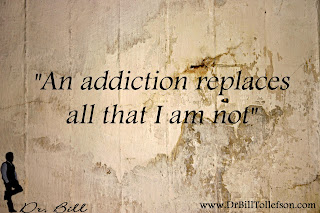7 Tips on Why Survivors Seek Addictions
The following are 7 tips on what to look for if you are a survivor who is experiencing intense PTSD symptoms and are attempting to fight them, numb them out or suppress them.
1. Hiding abuse or trauma symptoms because possessing
these symptoms are viewed in the mental health field as aweakness of character
Reacting to abusive or traumatic post experiences was seen as a weakness of personal character, particularly in men. The non-traumatized population understood that addictions were a disease, so survivors pick up on it and realized it was more acceptable to have an addiction and be a label for an addiction rather than Post-traumatic Stress Disorder (PTSD) so they would not in their mind be seen as weak or damaged.
2. To numb out emotional, cognitive, physical and
memory symptoms of Post-traumatic Stress Disorder
Survivors discovered getting habitually involved in certain behaviors, emotions, substances and thoughts initially reduced the vast array of PTSD symptoms. Each behavior, emotion, substance and thought attacks a different symptom. This is a reason that
many survivors have many different addictions. Once the effects of a PTSD symptoms are diminished, the individual is already into a severe or toxic stage of addiction.
3. To fight negative thoughts that seem to originate
out of thin air
First of all, “every addiction starts with a thought or set of thoughts.” Survivors find out that thoughts are his or her most powerful enemies as well as allies. So the survivors create and enlist addictions to a substance or inanimate objects to eliminate the constant excruciating, upsetting and damaging noise of negative looping thoughts (thought addiction) which seems to surface out of thin air. This unwanted negative looping thoughts seem to surface out of a dark place in the subconscious and come racing into the conscious. This occurs due to a trigger. This trigger then causes a flashback or a memory related to a past traumatic experience.
4. To increase denial of reality through “gas lighting” self
The definition of gas lighting is to undermine yourself or
another's perception of reality. To create a false inner reality to veil any knowledge or memory of a past event or situation and what happened. The one main thing a survivor does not want to realize is that he or she was abused or traumatized and he or she was changed forever forming a core belief of “I will never be the same again.”
5. To produce a false sense of security
Many survivors live in a constant fear of everything around
them. Having addictions gives survivors a false sense of
being safe, something to focus on and alleviates emotional
uptake.
6. To mask PTSD symptoms with addictions
If both the addiction and PTSD are not treated together, a resurgence of PTSD symptoms will send a survivor into an addiction relapse. Conversely, if he or she relapses due to a craving on an addiction relapse to mask over the surfacing PTSD symptoms.
7. To reduce re-experiencing of recollections of past traumatic events
Traumatic memories or flashbacks is one of the main and
worse symptoms of PTSD. Survivors who are re-experiencing traumatic memories or flashbacks will attempt to control,
fight or suppress these through addictive patterns, behavior, thoughts or substances. A survivor will turn to taking illegal
or legal substances (alcohol or drugs or prescribed pain or
mental health medication) to block out flashbacks (visual, emotional, and auditory as well as body memories) or
participate in unhealthy behaviors (eating or depriving of
food, pornography, self-harm, self-sabotage, sex, and/or
excessive exercise) to mask over suffering PTSD symptoms
as well as engagement in repetitive harmful thoughts and/or destructive relationships to block out hurt and pain of re-experiencing
what happened to them.
Take Away
Not only does a survivor use an addiction to stop one of the seven reasons mentioned above but would enter into more than one addiction at a time to accomplish his or her goal to suppress suffering PTSD symptoms and hide the symptoms from the world.
A survivor may even be juggling 7 different addictive relationships at the same time to resolve all 7 reasons above.
If you are a survivor who has addictions it is important to face and heal both your PTSD symptoms and addictions at the same time otherwise one will counter act the other causing a relapse in one or both.
Coach Bill
More information on a website or click here to download free eBook




Dear Andrea,
ReplyDeleteThank you for your comments. I really appreciate it a lot. Hope you read more of my blogs and follow me.
Blessings, Dr. Bill Tollefson
This comment has been removed by the author.
ReplyDelete